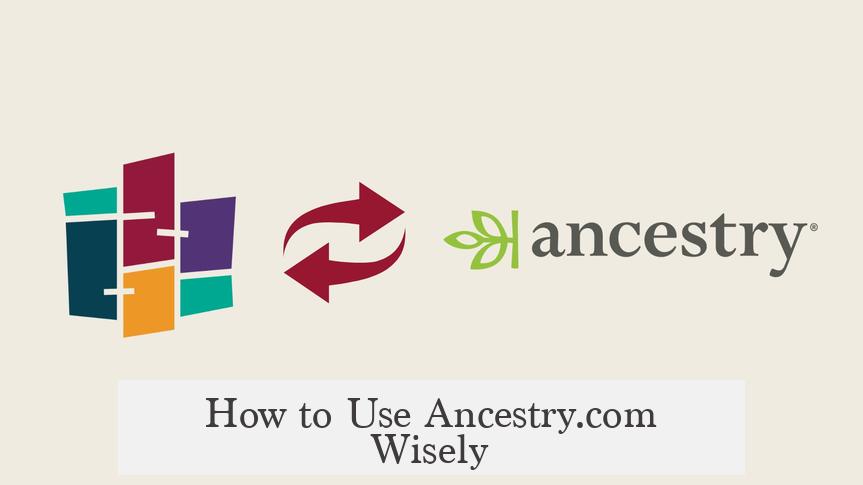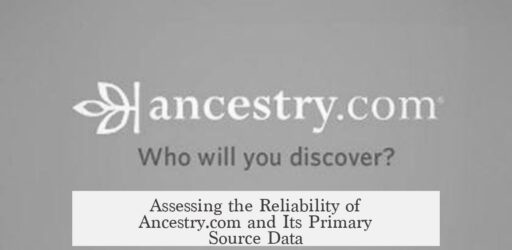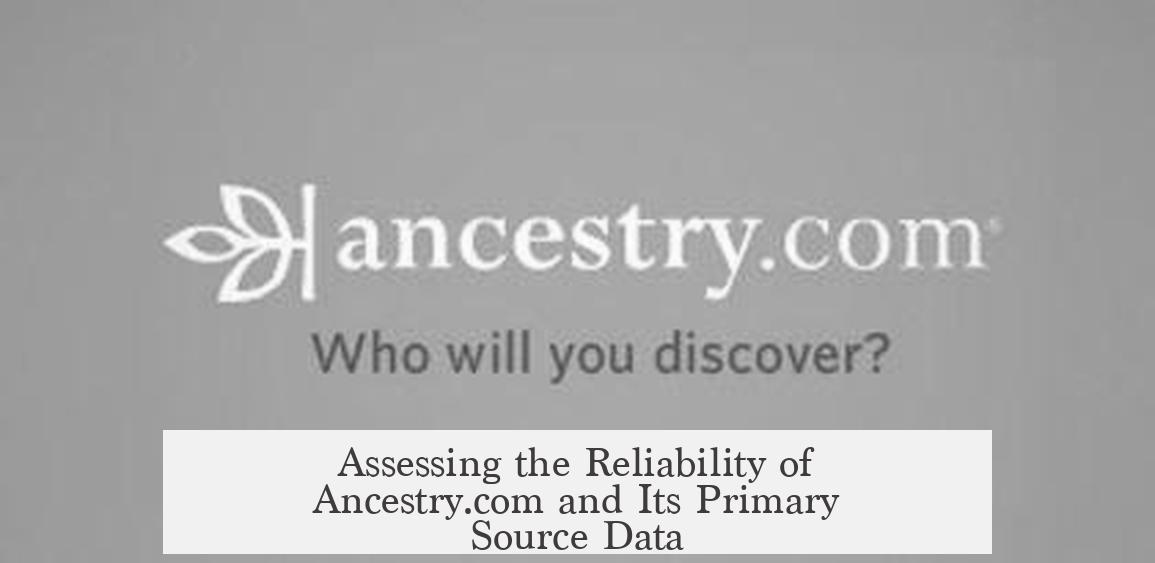Ancestry.com is generally reliable when it comes to providing access to primary source documents, but caution is needed when using user-constructed family trees and dealing with potential transcription errors.
Ancestry.com hosts a vast collection of digitized primary source records. These include census data, birth, marriage, and death certificates, military service files, immigration papers, land deeds, newspapers, and city directories. These records are original documents created at or near the time of the events, qualifying them as primary sources. Their digitization effort provides one of the most extensive online genealogical data collections available today.
However, the platform’s primary source documents have a caveat. Digitization and transcription processes can introduce mistakes. Handwritten records, often containing difficult cursive or degraded ink, are sometimes misread when converted into searchable text. An example is a letter “g” being mistaken for an “s” in surnames. Additionally, historical census takers or record keepers might have recorded names incorrectly or inconsistently at the time, further complicating the task.
While Ancestry.com often holds original record images alongside indexed data, users should verify details directly on document copies rather than rely solely on search results or transcriptions.
The platform also allows users to create, share, and link family trees. This is where reliability concerns grow stronger. Many user-generated trees lack proper documentation. Some users build trees based on assumptions, oral family stories, or by copying others’ research without verification. This can propagate errors and speculative connections, even linking to mythical or historically inaccurate ancestors without evidence.
- User trees should never be accepted uncritically.
- Cross-referencing multiple primary records is essential before adding information to your own research.
- Photos, notes, or family stories from user trees can be helpful if substantiated, but should not replace evidence from primary documents.
Effective genealogical research on Ancestry.com requires a systematic approach. Start with yourself and known relatives. Move backward through verifiable records, corroborating data from at least two independent primary sources where possible. Avoid merging broad surname-based groups or importing large chunks of others’ trees without scrutiny. Due diligence can minimize mistakes and refine a well-supported family tree.
Geographic and cultural coverage on Ancestry.com is strongest for European and North American records, especially English-language documents. Its database is less comprehensive for some world regions, including Asia, parts of Latin America, and the former Soviet Union. Researchers tracing non-Western ancestries may find limited or no relevant records. Alternative specialized regional or national genealogy resources may be required for such research.
Lastly, users should be aware of some practical limitations. The search engine sometimes returns large numbers of irrelevant records, requiring patience and careful filtering. Subscription renewals default to auto-renewal, which users can manage via account settings.
| Aspect | Reliability Notes |
|---|---|
| Primary Documents | Generally reliable; original or closely sourced records digitized; possible transcription errors |
| User-Generated Family Trees | Variable reliability; prone to unverified assumptions and copying errors |
| Transcription Errors | Common in digitization; verify with original images |
| Geographic Coverage | Strong for Western/European ancestries; weaker for Asian, Latin American, Soviet regions |
| Search Functionality | Can produce too many irrelevant hits; requires refinement and due diligence |
- Ancestry.com provides extensive digitized primary source documents that are generally trustworthy.
- User-created trees often contain unverified or speculative data, reducing reliability.
- Transcription and indexing errors exist; always consult original images when possible.
- The site’s strength lies in Western and European records; coverage for other regions is limited.
- Critical examination and cross-referencing are key to creating accurate genealogies.
How Reliable is Ancestry.com? Is it Based on Primary Source Data?

In simple terms, Ancestry.com is very reliable when it comes to providing access to primary source documents, but its user-generated family trees are far less trustworthy without careful verification. Let’s unpack what that means and why it matters for anyone curious about their roots.
Imagine stumbling upon a treasure chest—inside, hundreds of census records, birth and death certificates, marriage licenses, land deeds, military records, and even old city directories. Ancestry.com is exactly that chest, digitized and searchable. These records are the backbone of genealogical research and are considered primary source documents. That means they are original, first-hand records created at the time of the events they describe. Using these primary documents, you can piece together a family story that’s as close to fact as possible.
But—and there’s always a but—the story gets hazy when you dive into the family trees other members build and share on Ancestry.com.
What Makes Ancestry.com Documents Reliable?
The majority of documents on Ancestry.com are digital versions of primary sources. This includes census data dating back centuries, court and church records from the UK, vital records like birth and death certificates, military and immigration documents, and even obituaries and old newspaper clippings. It’s like having a global archive at your fingertips.
For example, the UK census records on the platform extend hundreds of years back. Church and court records can go even further. If you’re thorough, you can build your family tree almost exclusively on these verifiable documents.
These records have been painstakingly scanned and digitized, so you’re not digging through dusty files yourself. The sheer quantity and variety of these sources are possibly the most comprehensive available online.
The Catch? Digitization Isn’t Perfect
While these are primary sources, errors can creep in during digitization. Picture a 19th century handwritten census form. The clerk who wrote it might have had terrible handwriting—and the person transcribing it into the digital database might misread an “s” for a “g” or vice versa.
One user shared finding ancestor names where their mother’s maiden name had a lower case “g” transformed into an “s” because of such transcription errors. Sometimes, the original census takers misspelled names or spelled them phonetically, adding another layer of uncertainty. Plus, some states limit online records to indexes that don’t provide complete proof, making it hard to be sure you’ve found the right ancestor.
So, while the documents themselves are trustworthy as original records, the way they’re recorded and digitized means you need to be cautious and double-check entries where possible.
Why User-Created Family Trees Can Be a Genealogical Minefield
If the documents are the bedrock, user-submitted family trees often feel more like a shaky scaffold built from hearsay, guesswork, and sometimes outright invention.
People get excited about famous ancestors or romantic stories and sometimes allow wishful thinking to cloud their judgment. It’s common for folks to copy and paste an entire family tree from someone else without verifying the underlying sources, perpetuating mistakes that can span generations.
For example, you might see a sprawling family tree with a neat little green leaf icon that promises links to other people’s trees. But these “leaves” aren’t badges of authenticity—often, they represent unverified claims and assumptions based mostly on matching last names or birth dates. You could end up with a family tree claiming a descent from Julius Caesar—which sounds cool but needs a heavy dose of skepticism!
One experienced genealogist revealed a personal rule: they avoid user-submitted trees altogether, preferring to build their own tree from scratch using only verified primary documents. The only exception? Photographs, but even then, only if a photo can be conclusively tied to an individual.
How to Use Ancestry.com Wisely

So, how do you avoid falling victim to misinformation on Ancestry.com? The answer is simple but often overlooked: cross-check everything.
- Verify every piece of information you add to your tree by referencing the original primary documents.
- Don’t import large chunks of family trees created by strangers without examining the original sources for those connections.
- Don’t rely solely on matching names or dates to assume relationships.
- Be cautious of family legends and stories that lack documented evidence, especially those that sound too good to be true.
Critical thinking is your best friend. By cross-referencing multiple primary sources, you ensure the family story you build is as factual and accurate as possible.
Geographic and Cultural Coverage: Is Ancestry.com Global?
Here’s where the plot thickens: Ancestry.com’s strongest suit lies in Western, especially European and Anglo-American records. If your roots stretch deep into the UK, Ireland, or the US, you’ll find a treasure trove of information.
However, users with Asian, Latin American, or Soviet ancestry report much more limited access to primary documents. Non-English sources and paperwork often remain inaccessible or incomplete on the platform.
If you have family from Brazil or Spanish-speaking North America, the coverage is patchy compared to European records. And let’s be honest—trying to trace Asian or Soviet Union ancestry on Ancestry.com feels like searching for a needle in a haystack, because many such records haven’t been digitized or shared on this platform yet.
Challenges Beyond Data: Search and Subscription Hurdles
Some users get frustrated with the search experience. Enter a specific ancestor’s name and details, and Ancestry.com might flood you with thousands of unrelated results. A David Morgan from Glamorgan? There could be hundreds, born all in the same town and year. Sorting through them is a massive headache.
Also, watch out for the automatic subscription renewal. Ancestry.com automatically renews subscriptions unless you cancel upfront, which can be annoying if you forget.
A smart tip: immediately cancel after subscribing. You retain full access for the whole subscription period but stop auto-renewals from sneaking up on you.
Final Thoughts: How Reliable Is Ancestry.com, Really?
Because everyone shares ancestors if you go back far enough, the difference lies in how solid your paper trail is. That’s where Ancestry.com shines—offering an impressive array of primary documents to track that trail. But the platform is a tool—it depends on how you use it.
If you stick to examining primary source documents and apply critical judgment, Ancestry.com is a goldmine. However, if you depend on user-created family trees as gospel, be prepared for errors, myths, and occasionally, genealogical fantasy fiction.
In this sense, use Ancestry.com like a detective uses evidence: not everything is a smoking gun, but some clues are invaluable if approached with skill and care.
Some Practical Tips to Make the Most of Ancestry.com
- Start with yourself: Work backwards from the most recent verified relative. Avoid chasing legends first.
- Prioritize primary documents: Census data, birth and death certificates, and immigration papers are your best friends.
- Cross-reference user-submitted info: Treat family trees as leads, not facts.
- Beware transcription errors: Double-check spellings and details directly from digital images if possible.
- Know the platform’s limits: For non-Western ancestry, consider complementary sites or local archives.
- Manage subscriptions wisely: Cancel auto-renewal after purchase to avoid surprise charges.
At the end of the day, Ancestry.com serves as a powerful window into the past—but the clarity of the view depends on the quality glass you look through. Is it perfectly reliable? The documents mostly are. Are all the trees and claims on the site accurate? Absolutely not. Use it wisely, and your family history will unfold in fascinating, verifiable ways.



